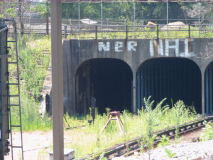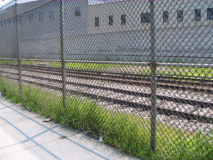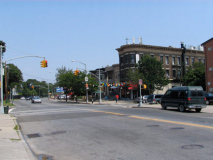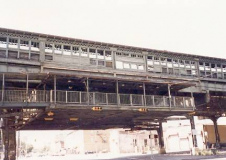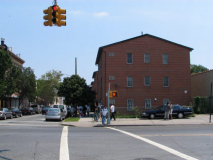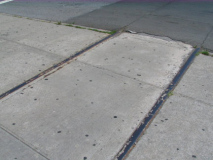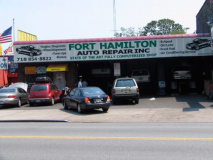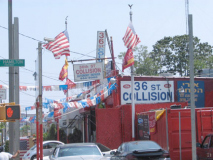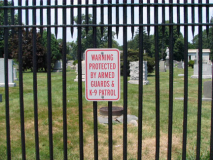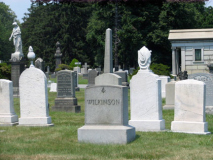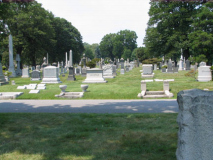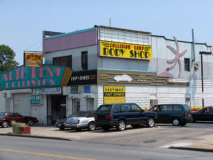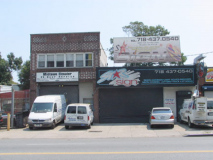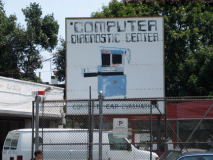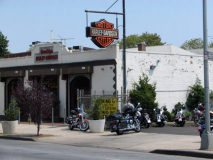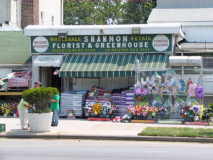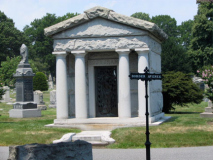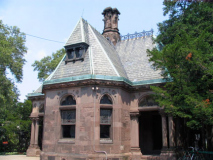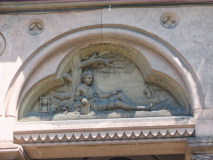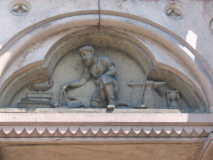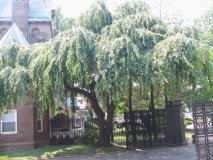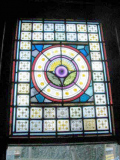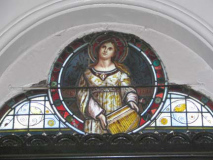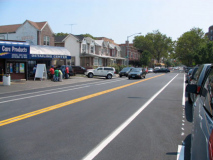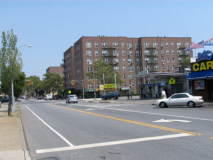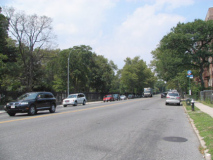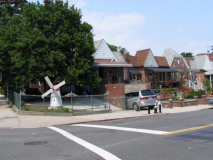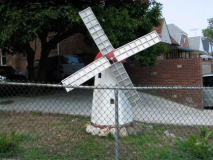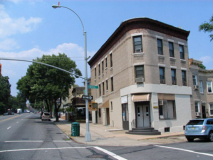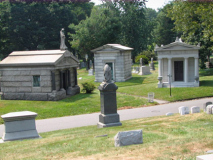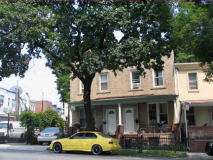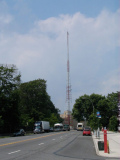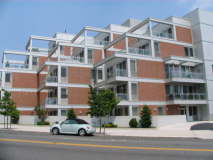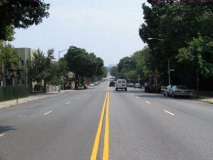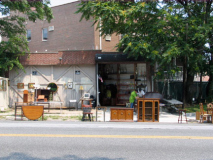A Lost Railroad
Between 1954 and 1975 the right-of-way between 37th and 38th Streets was partially occupied by an elevated railroad that served as a shuttle between the West End line and the Culver Line (now the F train). The tracks themselves were once part of the Culver, which ran from Union Depot to Coney Island from 1875 onward by horsecar, steam and electric power. Before World War II, the decision was made to connect the IND 6th Avenue Line to the Culver with some connecting track between the Church and Ditmas Avenue stations, but this plan was delayed by World War II.
Above left, we see the portals through which the Culver Shuttle emerged from an underground level at the 9th Avenue station. The tracks at right are now layup tracks but were once part of the South Brooklyn Railway (see below)
By 1954, however, the connector was completed, orphaning the tracks from the 9th Avenue and Ditmas Avenue stations. The Transportation Authority made use of these tracks, renaming them the Culver Shuttle. By 1975, however, that old bugbear, institutional neglect, had reared up again and the platforms, stations, and even rolling stock were in a state of severe deterioration. Facing a massive budget gap (as it does in 2008) the MTA decided to end service –yet, it did not have enough funds to demolish the old structure, which remained in place until 1985.
Fort Hamilton Parkway and 37th Street, at the southeastern corner of Green-Wood Cemetery, shown in 2008 (left) and 1985, as the ghost of the Culver Shuttle awaited demolition, having been allowed to rot for the better part of twenty years. photo right: Vincent Losinno
The Culver Shuttle right of way lay empty for several years after its demolition; there was talk of a park corridor, a la Lief Ericson Square, that didn’t pan out. Instead, the ROW became a mix of parking lots, used car dealers, and the occasional clutch of cheap housing shown above.
A curio in the Culver Shuttle story is the presence of freight line tracks, the South Brooklyn Railway (SBK) which ran underneath the Culver from the waterfront to the Coney Island Yards. The SBK is still used to transport new subway cars to the yards as, through the NY Cross Harbor Railroad and float car operations, it provides a link with America’s national rail network. However, by the late 1970s, the freight tracks along 37th Street and McDonald Avenue were eschewed in favor of hauling cars and other freight along the West End El, which itself has a connection with the Coney Island Yards, and so the street tracks were retired. However they, too, remained in place until the early 2000s, when a repaving job on McDonald Avenue tore them up for good (the sewer pipe work on Fifth Avenue that we saw earlier also served as an occasion to tear out Fifth Avenue’s remaining trolley tracks!) Two of the last remaining SBK tracks are shown here, as they cross Fort Hamilton Parkway. In their dotage, the SBK tracks were used infrequently — I remember them being used primarily as a staging area for bocce games.
Fort Hamilton Parkway
Fort Hamilton Parkway shows up early on Kings County atlases — it appears as early as the 1870s as it served as a connector from the then-more populated and developed Prospect Park area to Fort Hamilton itself, which was built in the 1820s. It was also the main artery of my youth, since I grew up walking on it to Shore Road to watch the Verrazano Bridge built.
Ft. Hamilton Parkway forms the southeastern boundary of Green-Wood Cemetery from 37th Street northeast to McDonald Avenue. The traffic is pedal to the metal here — quite the contrast from, say, placid, quiet 5th Avenue that we saw above. Traffic exits the Prospect Expressway and uses FHP as a conduit to Borough Park and Bay Ridge. All along the busy road we see auto repair and collision joints.
But the cemetery’s muffled serenity is not far away.
Though the cemetery has taken great pains to make itself more friendly and accessible in recent years (I seem to recall casual visits discouraged in the Super 70s) there must needs be vestiges remaining from the days when packs of vandals roamed the grounds.
A Miami-Vice themed auto body shop, in art direction at least, and Star Sign.
Oddly, Green-Wood, Brooklyn’s biggest cemetery, doesn’t have an inordinate amount of florists or stonecarvers on its rim — other cemeteries, especially in Queens’ cemetery belt, certainly do.
Remember when computers were considered incredibly futuristic — the idea of using one at home in the 70s and 80s was the ultimate high tech affectation. This sign dates back to those days.
One of Green-Wood’s most impressive mausolea, a Doric-columned building belonging to a Rosecrans. Outside is one of the cemetery’s distinctive street signs: the cemetery has a street system all its own, having nothing to do with Brooklyn’s overall street grid.
The door depicts a weeping woman looking within.
Eastern Entrance
At Fort Hamilton Parkway and Micieli Place, called the Eastern Entrance, we find the second of the Cemetery’s main entrances. Richard Upjohn’s massive arch at 5th Avenue and 25th Street gets most of the press, deservedly, but the buildings here, on what can be considered the Cemetery’s rear entrance, are almost as impressive. Was the visitor’s lounge, in brownstone that matches the arch, also designed by Upjohn? Jeffrey Richman’s Green-Wood cemetery tome, as well as the internet, are silent on that fact. The book does mention that British sculptor John M. Moffitt executed the Four Ages of Man works (two shown here) on the gatehouse. There’s a rare Brooklyn weeping beech here too.
ForgottenFan Ruth Edebohls: The buildings at the Eastern Entrance were in fact designed by Richard Upjohn and built in 1876.
I was shooed off by a guard but not before obtaining these shots. Perhaps a law enforcement official would like to inform me of any possible reason for restricting photography in a cemetery. Would it be:
a) a perceived vandalism threat
b) a perceived terrorist threat
c) enforcement of decorum, ie. mooks with cameras shouldn’t be desecrating the atmosphere
Inquiring minds want to know.
In any case, in November 2004 I got into the waiting room, no problem, and obtained these photos:
Some major stained glass work here and again, I have no idea about the details since most of the books focus on the 25th Street entrance. Can anyone fill me in on the glorious Eastern Entrance?
Brooklyn Roads
Some major Brooklyn arteries are found at Green-Wood’s sharp turn at the boundaries of Kensington and Windsor Terrace.
There’s Dahill Road (above left), with its well-marked bike lane (compare the one on 37th Street, above). Dahill runs in stops and starts from Fort Hamilton Parkway south to Kings Highway. The route forms a boundary of sorts between the street grids of Bay Ridge-Bensonhurst and those of Kensington, Midwood and Parkville. It’s the running buddy of McDonald Avenue (left) which forms the eastern boundary of the Cemetery from 10th Avenue south to FHP, but for most of its length it’s shadowed by the Culver El.
Caton Avenue (above right) once led to one of Brooklyn’s biggest candy stores, at Caton and Flatbush (the avenue’s chief interest for your young webmaster). It is a chief tributary of Linden Boulevard, which connects Flatbush with the Belt Parkway in Ozone Park.
McDonald Avenue
McDonald Avenue was called Gravesend Avenue until 1933, when it was renamed for a now-forgotten Brooklyn alderman who had died suddenly, having choked on a chicken bone. The city no longer does direct renamings like this, and instead now prefers to place a second sign under the original name. The road rises gradually as you go north to a peak at its end at 10th Avenue and 20th Street.
The owner of the house on the corner of McDonald Avenue and Greenwood (no hyphen) Avenue may or may not be aware that a windmill, a symbol of Holland, appears on NYC’s official seal as well as the city’s flag, as a hark back to the Dutch, who controlled NYC in the early colonial era until 1664.
At Vanderbilt Street (another boundary between Park Slope-Sunset Park-Bay Ridge and Flatbush street grids) a handsome round-cornered brick building looks out over several mausolea.
The massive Bishop Ford High School radio tower lords over all at the top of the hill at McDonald Avenue’s end, or beginning. I haven’t seen a porched house yet on the Cemetery’s exterior — this is the first. Meanwhile, newer mausoleum buildings, along with a new crematoria, have sprouted along Green-Wood’s edges.
The Queens Crapper will kill me, but I have a soft spot for The Simone, a new luxury complex at McDonald Avenue between Terrace Place and 20th Street (I like modernist buildings with straight, clean lines — I’m a Wright fan, and wish there were more Wright buildings in the NYC metro area; there are only three by my count).
Brooklyn blogger IMBY has poked fun at its marketing strategy: It’s not so much what’s in the Corcoran web site slide show, as what’s been left out that interests me. Specifically, any reference to the fact that the building site is practically at Death’s Door, being located directly across the street from Green-Wood Cemetery! [IMBY]
A typical apartment can be fetched for $875G.
And the road goes on forever. Meanwhile, next door, people with normal incomes hold a garage sale; as we’ve seen on North 10th in Willieburg, luxury is shoehorning itself into rather more modest locales in Brooklyn and the swells no longer have to cab it north of the park for some honest slumming. RIGHT, McDonald Avenue travels directly south from here almost as far as Coney Island.
Had enough? I haven’t. The final stretch is on Part 3.


